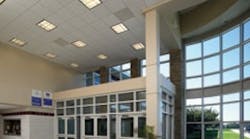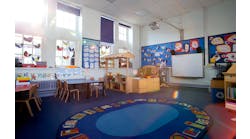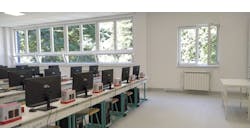In the 1970s, concern about a looming energy crisis led many designers to shy away from the practice of relying on daylight to illuminate classrooms and other school spaces. Fluorescent lights could make up the difference, and with fewer openings for windows, a school building would not have so much of its heating and cooling energy leak out.
Today, schools and universities still fret about wasting energy, but windows no longer are seen as an enemy of energy efficiency. For the last decade or so, schools and universities have recognized daylight as a critical item in the recipe for energy conservation and as a desirable classroom characteristic that can enhance student performance.
So, the more windows, the better, right? Not so fast.
Out of the glare
If you think all daylight is desirable, try driving a car west at dusk. The blinding glare can make driving uncomfortable if not hazardous. In the same way, allowing the glare of sunlight to enter a classroom and shine directly on the faces of students and teachers can hinder learning.
“Direct sun penetration into classrooms, especially through unshaded east- or south-facing windows, is associated with negative student performance, likely causing both glare and thermal discomfort,” says an often cited report from Heschong Mahone Group on daylighting in schools.
In addition, direct sunlight brings with it unwanted heat that boosts energy consumption and ultraviolet rays that can cause degradation of materials in a learning space.
“A properly daylighted building uses carefully placed windows, shading devices and low-transmittance glass — techniques that block direct sunlight and greatly reduce glare,” says the Daylighting Collaborative, which was created by the Energy Center of Wisconsin.
Put it there
Building designers seeking to maximize daylighting should orient the facility on an east-west axis. That “will allow for capturing winter solar gain and reducing unwanted summer sun that strikes the east- and west-facing surfaces,” says the U.S. Department of Energy's Building Technologies program.
Careful window placement also helps a building realize its daylighting potential. Windows facing north and south create the fewest problems.
“By employing south-facing apertures, you create a situation that is easy to control through the use of external window-treatment strategies,” says the “Design Guide for Daylighting Schools,” put together by the architectural firm Innovative Design. “In the summer, the least amount of radiation hits the south, vertical surface of your school; and in the winter, the most radiation strikes this surface.”
Going higher
The best way to bring natural light into a facility without detracting from the learning process is through high openings that are not used by occupants for viewing the outside environment. Commonly used techniques include clerestories, light shelves, roof monitors and skylights.
Clerestories are windows along a wall and above eye level. Because of their height, they allow daylight to penetrate deeper into a space. Lightshelves that are perpendicular to the clerestories can reflect the daylight and transmit it even farther into a room. Roof monitors — a vertical glazing atop a facility — admit daylight through the ceiling.
Architectural elements such as overhangs and other elements, such as baffles and shades, can further diffuse and filter the daylight.
“The Design Guide for Daylighting Schools” recommends that planners consider roof monitors first and lightshelves second.
“Roof monitors that incorporate vertical, south-facing glazing, properly sized overhangs and interior baffles have an advantage because they create uniform daylight throughout the space,” the guide says.
South-facing lightshelves are the next best option, the guide asserts. They can be used in multi-story facilities and typically cost less than roof monitors.
A flat, uncontrolled skylight on a roof “is typically the worst energy choice when considering daylighting options,” the guide says. It delivers more sunlight in the summer than in the winter, the opposite of what is desired.
Taking control
The effects of daylighting are enhanced when the design provides ways to adjust lighting when conditions change.
That could mean dimmers, and occupancy- or photosensors. Many teachers prefer to be able to control light in their classrooms manually.
“The Design Guide for Daylighting Schools” says glazing choices should be based on whether a window is to provide a view or bring in daylight.
“Make a clear distinction between glazing that is incorporated for views and ventilation, and that which provides daylighting,” the guide says.
For windows that are used specifically for daylighting, clear glass is better than glazing with a low-E coating, the guide states. Low-E coatings reduce the amount of visible light transmitted and diminish the daylighting benefit.
Computer software packages have been developed to help school planners find the most effective daylighting plan. But even with the help of technology, schools and universities have to take into account the unique conditions and characteristics of each building.
“Daylighting will always be a mix of art and science, of logical thinking and common sense,” says the Daylighting Collaborative. “Climate and geographical region, building type and use, and building orientation are big factors in designing a successfully daylighted building.”
Helping to see the light
Here are some sources on the World Wide Web for information about daylighting:
-
The Daylighting Collaborative: www.daylighting.org
-
Daylight Dividends: www.lrc.rpi.edu/programs/daylighting/
-
”The Guide for Daylighting Schools:” www.lrc.rpi.edu/programs/daylighting/pdf/guidelines.pdf
-
”Daylighting in Schools,” the 1999 report that Heschong & Mahone Group completed for Pacific Gas & Electric Co.: www.pge.com/includes/docs/pdfs/shared/edusafety/training/pec/daylight/SchoolDetailed820App.pdf
-
The Collaborative for High Performance Schools, Best Practices Manual, Design-Lighting and Daylighting: www.chps.net/manual/documents/BPM_2006_Edition/CHPS_II_2006_Lighting_and_Daylighting.pdf
-
The U.S. Department of Energy's Building Technology Program, Daylighting: www.eere.energy.gov/buildings/info/design/integratedbuilding/passivedaylighting.html
-
”Tips for Daylighting with Windows:” http://windows.lbl.gov/daylighting/designguide/dlg.pdf
-
The Los Alamos National Laboratory Sustainable Design Guide: www.eere.energy.gov/buildings/highperformance/lanl_sustainable_guide.html
-
Energy Design Resources: www.energydesignresources.com/resource/163 and www.energydesignresources.com/docs/db-01-glazing.pdf
-
The Efficient Windows Collaborative: www.efficientwindows.org
75% to 89%
Solar transmission of clear
single-pane glazing.
45% to 50%
Solar transmission of clear,
double-pane low-E glazing.
30% to 45%
Solar transmission of low-E,
tinted grey glazing.
Source: Daylight Dividends, Lighting Research Center, Rensselaer Polytechnic Institute, “Guide for Daylighting Schools”





